
Acne is a common skin condition that affects millions of people worldwide. In fact, according to a study, 9.4% of the global population struggle with it, making acne one of the top few concerns people around the world face. For some of us, acne triggers a cascade of negative emotions, but in other cases, it has the potential to cause discomfort and lower your quality of life. What’s worse is, it can leave behind a frustrating reminder in the form of scars and significantly impact your appearance and skincare routines. To help you better care for your skin and prevent both acne and acne scars, we’ve put together a comprehensive guide about them below. Read on to learn more.
1.1. Causes of Acne
Before we dive into the details of acne scars, we need to first understand their root cause—acne.
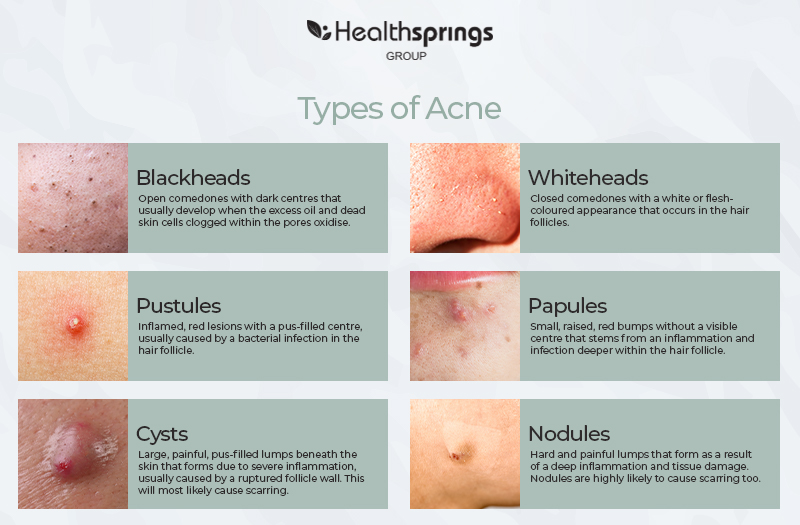
Acne forms when our hair follicles become clogged with oil and dead skin cells. A few different types of acne may appear, including black heads, whiteheads, pustules, papules, cysts and nodules. These acne may develop as a result of the below factors:
-
Hormonal Changes
Puberty, menstrual cycles, or pregnancy are periods of life accompanied by fluctuations in your hormones. During which, the sebaceous glands on your skin may be stimulated to produce more sebum (oil). Excess secretion of sebum can increase the risk of your pores becoming clogged, resulting in acne formation.
-
Genetics
Acne has a strong link to genetics, which means that if your parents had a history of acne-prone skin, your chances of developing it increases as well. This is because certain genetic factors can influence how your body responds to hormonal changes and how effective your skin can regulate oil production.
-
Bacteria
On our skin lives a bacterium known as Propionibacterium acnes (P. acnes), which is a non-pathogenic bacteria responsible for keeping harmful bacteria away from your pores. However, like anything in life, moderation is key. When this bacteria multiplies due to excess sebum, they can cause inflammation and contribute to the formation of acne lesions.
-
Dietary Factors
While the relationship between diet and acne is still an area of ongoing research, some studies suggest that certain dietary factors may influence acne development. Diets that include refined sugars, processed foods high in oils, and dairy products, have been associated with an increased risk of acne in some individuals. The consumption of a balanced diet filled with nutrients like vitamin A and D has also been shown to be able to promote healthier skin, which translates into acne prevention.
-
Stress
Chronic stress can affect hormonal balance, potentially worsening acne symptoms. Stress hormones, such as cortisol, may stimulate the sebaceous glands to produce more oil, contributing to the development of acne.
Understanding Acne Scars
2.1. How Do Acne Scars Form?
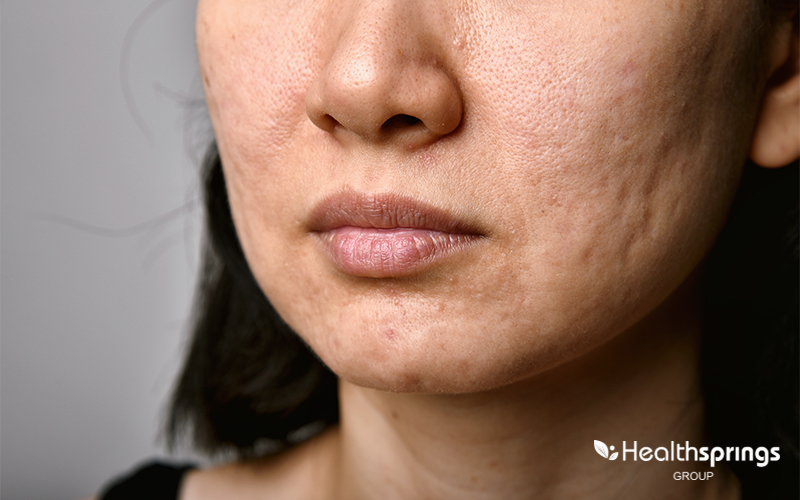
Acne scars are the lasting reminders of a battle waged beneath the skin’s surface; they are the result of the skin’s healing process after inflammatory acne lesions, such as pimples or cysts, have damaged the deeper layers of the skin. A number of complex biological processes cause scars to form. Here’s a look at them.
-
Collagen Disruption
Acne may develop when there’s excess P. acnes bacteria on your skin. As your immune system fights the infection, your body releases inflammatory molecules that can harm the tissues surrounding the acne. Collagen, a crucial protein providing structural support to your skin, becomes a casualty in this process. In some severe cases, collagen fibres may become damaged due to inflammation, disrupting the skin’s normal architecture. As a result, depressions or raised scars may appear.
-
Post-Inflammatory Hyperpigmentation
Apart from damages to collagen, post-inflammatory hyperpigmentation (PIH) may also occur following any inflammatory processes that happen on the skin. PIH is the darkening of the skin at the site of the acne lesion, usually due to an overproduction of melanin (the pigment responsible for skin colour). This process can be triggered when the skin is inflamed. Although PIH is not a scar, it can accompany the scarring process and contribute to the appearance of skin imperfections.
-
Remodelling Phase
As the body heals in a process called the remodelling phase, fibroblasts, which are specialised cells in the skin, will work to repair damaged tissues by producing new collagen fibres. However, the quality and organisation of this new collagen may differ from the original, resulting in the formation of scars.
Learn More: How to Remove Pigmentation from Face Permanently
2.2. Types of Acne Scars
Acne scars are a common concern for many individuals who have experienced severe or persistent acne. They can vary in appearance and may require specific approaches for effective treatment. Understanding the characteristics of different acne scars can empower you to make informed decisions about your skin care.
-
Atrophic Scars
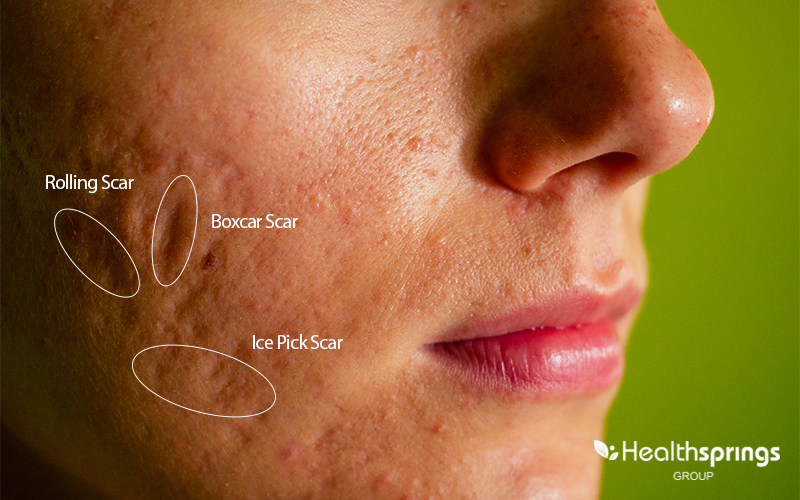
Atrophic scars are characterised by a loss of tissue, resulting in a depressed or pitted area on the skin. This happens when the skin fails to regenerate tissue properly following an inflammation caused by acne. The severity of inflammation and your body’s response to it play a role in the formation of atrophic scars. Treatment options may include laser therapy, chemical peels, microneedling, and dermal fillers to restore volume and improve the appearance of atrophic scars.
There are three main types of atrophic scars: ice pick, boxcar, and rolling scars.
– Ice Pick Scars
Ice pick scars are deep, narrow, and they extend into the skin. They resemble small puncture wounds, and are particularly challenging to treat due to their depth. When inflammatory acne lesions destroy collagen on your skin, ice pick scars will form.
Punch excision, laser resurfacing, and chemical peels can help to smooth the skin’s surface and reduce the appearance of ice pick scars.
– Boxcar Scars
Broader, box-shaped depressions with well-defined edges are known as boxcar scars. They can vary in depth and are typically wider than ice pick scars. But, they result from the destruction of collagen too.
Laser treatments and chemical peels are common acne scar treatments employed to promote collagen remodelling and skin smoothing, eliminating boxcar scars.
– Rolling Scars
Unlike the structured appearance of boxcar scars, rolling scars create a wave-like texture on the skin’s surface and have undefined borders. They develop when fibrous bands of tissue form between the outer (epidermis) and deepest layers of skin (subcutaneous tissue).
Acne scar treatments like laser therapy and dermal fillers, can help fade rolling scars.
-
Keloid Scars
Keloid scars are raised and thickened imperfections that develop when our body goes through a healing process. After acne lesions cause damage to the tissue deep within our skin, the body may produce excess collagen during recovery, resulting in the formation of keloids. Your tendency of keloid scarring may depend on your genetics. Individuals with darker skin tones are generally more prone to keloid scars. Treatments like laser therapy can help with reducing this scar.
-
Hypertrophic Scars
Hypertrophic scars are raised, firm masses of tissue that develop at the site of healed acne lesions when there is excessive collagen production. Unlike keloid scars, hypertrophic scars do not extend beyond the original wound area. Genetic factors, as well as the intensity and duration of inflammation, contribute to their formation. Treatment options may include corticosteroid injections and laser therapy.
Acne Scar Treatment
3.1. Topical Treatments
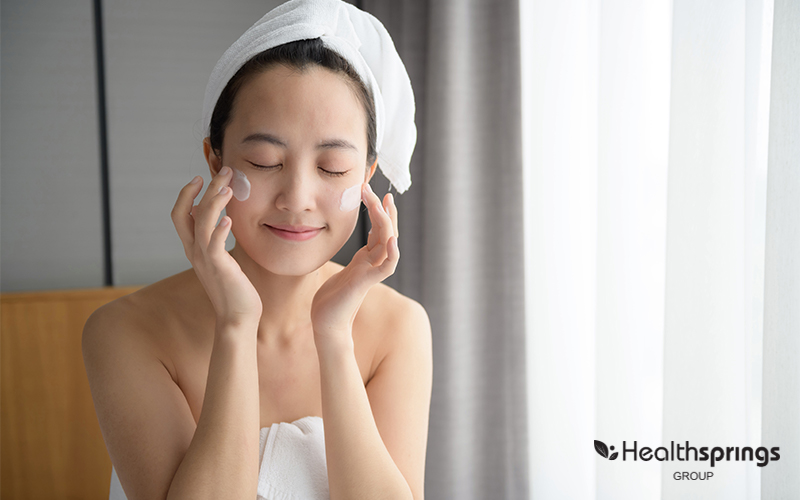
Topical acne scar treatments offer a simple and convenient way to minimise the appearance of scars and promote skin healing. While they may not be as efficient as in-office treatments, they can be ideal options for those who prefer DIY solutions.
Topical treatments come in many forms, including creams, lotions, serums, gels, and ointments. However, this isn’t the most important because the key lies in the active ingredients these products contain. Here are some contents you should be looking out for when selecting topical acne scar treatments:
-
Retinoids
Derived from vitamin A, retinoids promote cell turnover and collagen production. They work by speeding up the rate at which old skin cells are shed and new ones are generated, promoting the formation of new, healthy skin cells to improve skin texture and fade hyperpigmentation. However, retinoids may cause initial irritation or dryness, and sun protection is crucial to prevent increased sensitivity.
We recommend using Healthsprings’ Clarifying Glow Facial Scrub, which is an exfoliator formulated with bamboo beads and retinol. It gently buffs away dead skin cells and impurities to refine your pores, diminish scars, and even out complexion for a brighter and more radiant skin.
-
Alpha Hydroxy Acids (AHAs)
AHAs, such as glycolic acid and lactic acid, are capable of exfoliating the outer layer of the skin. In this process, they promote cell turnover, helping to fade hyperpigmentation, improve the texture of the skin, diminish the appearance of scars, and enhance overall skin tone. AHAs may cause mild irritation, and sun protection is essential during use too.
Looking for a solution to lighten acne scars? Healthsprings’ Glow Serum contains the necessary AHAs you need for glowy skin. It helps to reduce blemishes and pigmentation to give you a clearer complexion.
-
Vitamin C
Vitamin C, or ascorbic acid, is an antioxidant that encourages the synthesis of collagen, a protein crucial for skin elasticity. It also has skin-brightening properties. By using vitamin C, you can reduce inflammation, boost collagen production, and fade dark spots associated with acne scars. Be sure to choose stable forms of vitamin C, as it can make your skin sensitive to light and air. Healthsprings’ Vitamin C Gold Serum is an option you can consider. It has a stabilised and unique formula designed to combat premature ageing and pigmentation in combination and mature skin.
-
Niacinamide
Also known as vitamin B3, niacinamide has anti-inflammatory properties and the ability to support the skin barrier function. It reduces redness and hyperpigmentation, and can help with improving overall skin texture. Niacinamide is an ingredient well-tolerated by most skin types, making it a suitable option for individuals with sensitive skin.
-
Hyaluronic Acid
Hyaluronic acid is a hydrating ingredient that aids in retaining moisture in the skin. It plumps up the epidermis, reduces the appearance of fine lines and scars, and even promotes wound healing. While it is generally safe for all skin types, those with extremely oily skin may want to use it in moderation.
-
Peptides
Peptides are short chains of amino acids that support collagen production and promote skin renewal. When used, it enhances skin elasticity, reduces fine lines, and aids in scar repair. It is suitable for various skin types, but results may take some time to become noticeable.
Give your skin a boost of hydration with Healthsprings’ Hydrating Sleeping Mask, infused with active ingredients like palmitoyl tripeptide-1, palmitoyl tetrapeptide-7, sodium hyaluronate and pracaxi oil to deeply hydrate and nourish your skin during the night.
It’s essential to note that individual responses to topical treatments can vary, and consistent use, along with proper sun protection, is key to achieving optimal outcomes.
Learn More: Say Goodbye to Acne Scars With These 5 Treatments
3.2. In-Office Procedures
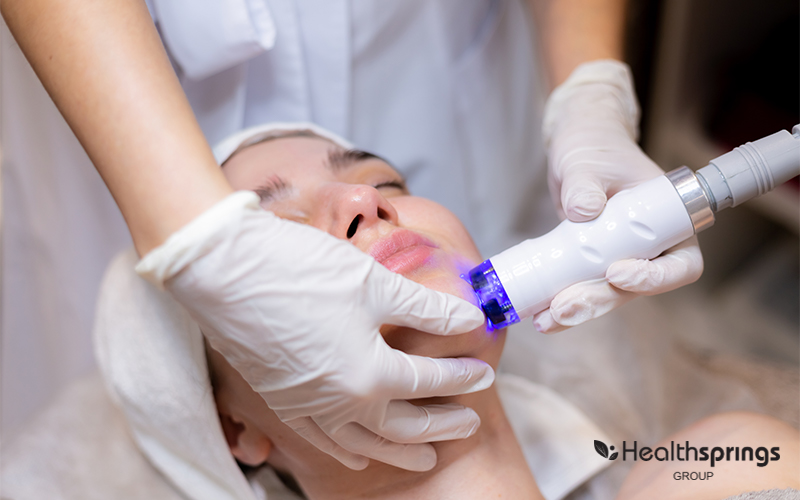
In more severe cases, or for quicker resolution of your acne scars, you may wish to visit a medical aesthetic clinic for in-office treatments that target deeper layers of the skin. From microneedling to laser treatments for acne scars, these options harness technology to give you the complexion you desire.
-
INFINI RF Microneedling
INFINI RF Microneedling is a minimally invasive treatment that combines radiofrequency (RF) technology with microneedling to stimulate collagen production and improve skin texture. Fine needles and RF energy both penetrate the skin to deliver results.
A numbing cream will be applied to minimise discomfort during the treatment. Multiple sessions are generally advised for optimal outcomes.
-
Fractional CO2 Laser
Fractional CO2 laser treatment employs a carbon dioxide laser beam to target and remove damaged skin cells in fractions. As it stimulates collagen regeneration, collagen fibres are also remodelled to even out skin textures, and the height and visibility of acne scars will reduce. Patients may experience redness and peeling for a few days up to a week following this treatment, but results are generally long-lasting with occasional maintenance sessions.
-
Fotona 4D Laser
Fotona 4D Laser uses a combination of laser wavelengths to address various skin concerns, including acne scars. It’s a four-dimensional treatment that targets both the surface and deeper layers of the skin.
Firstly, a non-ablative laser will be used to stimulate collagen production. Next, specific areas of pigmentation, fine lines, and wrinkles will be addressed with a fractional laser. Then, laser energy will be delivered in controlled, long-pulses to heat the deeper layers of skin. This breaks down pigmented lesions in the skin to allow the body to clear them away naturally. Finally, a light erbium laser peel will be applied to exfoliate the epidermis, improving texture and promoting a smoother complexion.
Fotona 4D Laser is safe for all skin types, but do consult a professional to determine your suitability. Some improvement may be noticeable after the first session, but a series of treatments is often recommended for optimal results.
-
Revlite Laser
Revlite laser utilises laser technology, specifically selective photothermolysis, to target irregular pigmentation without causing harm to surrounding skin.
As the laser energy is absorbed by melanin and haemoglobin in the skin, it generates heat to stimulate collagen production. This encourages collagen fibres to remodel, improving their organisation and reducing the appearance of acne scars.
-
Forever Young BBL (BroadBand Light)
Forever Young BBL is a non-invasive light therapy that uses broadband light—a unique dual-lamp technology delivering broad-spectrum light—to gently heat the epidermis, promote collagen production, and trigger the body’s natural healing processes.
Pigmentation concerns like sunspots and age spots, redness, and acne scars can all be addressed with this laser treatment. There is minimal to no downtime, and patients can resume normal activities immediately. However, a series of sessions may be required to achieve optimal results.
Preventing Acne Scars
4.1. Establishing A Skincare Routine
Maintaining healthy skin and preventing acne scars require consistent skincare habits. Here’s a step-by-step guide to help you establish an effective routine.
Step 1: Gentle Cleansing
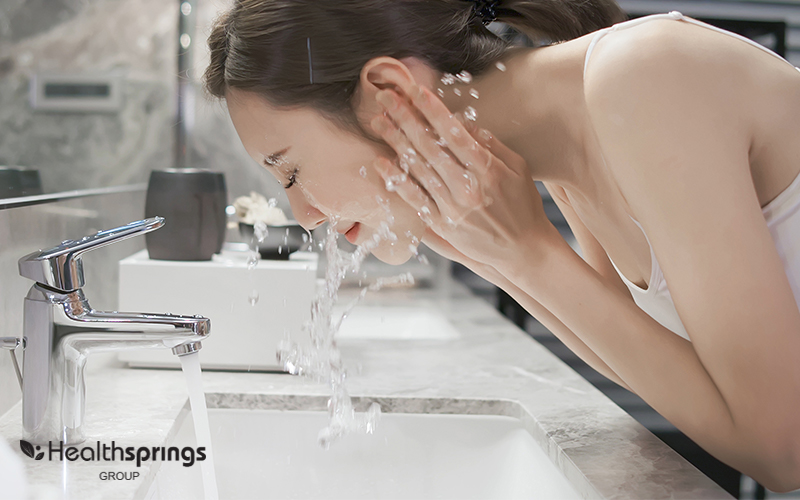
Always begin your routine with a gentle cleanser, such as Healthsprings’ Gentle Facial Cleanser, to remove dirt, excess oil, and makeup from your skin. You’ll need these impurities removed to prevent them from getting stuck in your pores and causing an infection.
Look for a mild, non-comedogenic cleanser that won’t clog your pores and avoid harsh products. Cleanse twice a day, in the morning and before bed, and handle your skin gently to prevent irritation.
Step 2: Exfoliate
Remove dead skin cells from your skin by exfoliating at least once to twice a week. This prevents them from clogging your pores and causing breakouts. Chemical exfoliants like those containing salicylic acid or glycolic acid are great options.
Be careful not to over exfoliate, as it can strip your skin of moisture and worsen inflammation. Also, apply sunscreen regularly to protect your skin from sun damage.
Step 3: Acne Treatment
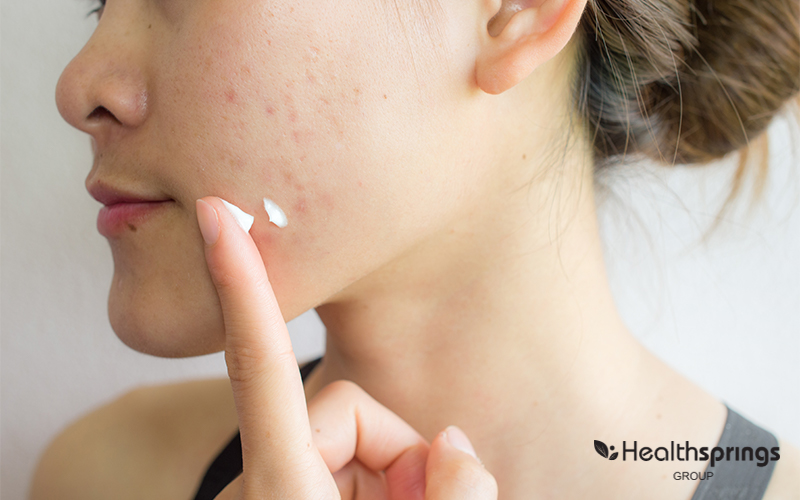
Experiencing acne breakouts? Incorporate a targeted acne treatment into your routine to reduce inflammation and prevent new eruptions. Products containing salicylic acid or centella asiatica, such as Healthsprings’ Comedone Cream, can be helpful. If you’re new to acne treatments, start with a lower concentration of active ingredients and gradually increase as your skin builds tolerance.
Step 4: Hydrate
Use a lightweight, non-comedogenic moisturiser to keep your skin hydrated. Even if you have oily or acne-prone skin, moisturising is essential to maintain a healthy skin barrier and to prevent more breakouts. Look for ingredients like hyaluronic acid or glycerin.
It’s important to moisturise your skin, especially after using acne treatments, as those products have the tendency to dry out or irritate the skin.
Step 5: Sun Protection
Exposure to the sun’s harmful ultraviolet rays can worsen hyperpigmentation and make scars more noticeable. Be sure to apply a broad-spectrum sunscreen with at least a Sun Protection Factor (SPF) of 30, even on cloudy days, to protect your skin. Choose products labelled as non-comedogenic to avoid clogging your pores.
Healthsprings’ Glow Sunblock SPF 60 is a non-greasy sunscreen that protects against both UVA and UVB rays. It’s also enriched with antioxidants that help protect your skin against oxidative damage while shielding it from the sun.
Additional Skincare Tips to Follow:
- Avoid Picking or Popping Pimples: Picking at acne can lead to scarring. Let blemishes heal naturally to minimise the risk of scars.
- Stay Hydrated: Drink plenty of water to keep your skin hydrated from the inside out.
- Maintain a Healthy Lifestyle: Consume a balanced diet rich in fruits, vegetables, and whole foods, and take steps to manage stress. For example, yoga or meditation.
- Consult a medical aesthetic doctor: If you struggle with persistent acne or are unsure about suitable products, seek advice from a medical aesthetic doctor for personalised advice and treatments.
4.2. Bad Habits to Avoid

Besides effective skincare, you’ll also need to practise good hygiene and avoid certain bad habits to prevent acne scars. Some of these actions have the potential to exacerbate acne conditions and hinder the healing process.
- Picking or Squeezing Pimples: Doing so can rupture the follicle wall and allow bacteria and debris to spread beneath the skin, increasing the likelihood of scarring.
- Neglecting Your Skincare: Not adhering to a consistent regimen can contribute to acne and, subsequently, scarring. Regularly cleansing, exfoliating, and moisturising are essential to maintain healthy skin and prevent breakouts.
- Using Harsh Products: Overusing skincare products or using those that contain substances you’re sensitive to can strip your skin of its natural oils, causing dryness and irritation. This can aggravate existing acne and contribute to scarring.
- Skipping Sunscreen: Exposure to the sun’s harmful UV rays can worsen hyperpigmentation and increase the visibility of scars. Always apply a broad-spectrum sunscreen with at least SPF 30, especially if you’re using acne treatments that may increase your skin’s sensitivity to sunlight. For example, vitamin C or retinol.
- Not Getting Ample Rest: Inadequate sleep can trigger hormonal changes that may exacerbate acne. Heading to bed early and getting at least eight hours of rest daily should be your priority if you wish to keep acne at bay.
- Using Dirty or Old Makeup Brushes: Your makeup brushes may harbour bacteria after prolonged use. Applying makeup with them introduces germs and bacteria to your skin, which can contribute to breakouts. Make sure you’re cleaning your brushes regularly and replacing old products to prevent irritation and potential scarring.
Frequently Asked Questions About Acne Scars
1. Can acne scars be completely removed?
Complete removal or acne scars may not always be possible, but in most cases, these scars can fade entirely with the right acne scar treatment.
2. How long does it take for acne scars to fade?
The timeline varies, but with consistent treatment, you may see improvement within a few months to a year.
3. How can I prevent acne scars?
Preventing acne scars start from your basic skincare routine. Early and effective management reduces the likelihood of acne developing on your skin, and prevents scarring. Establishing your own skincare regimen can aid in promoting healthier skin and lowering your risk of acne. We recommend consulting a medical aesthetic doctor for professional acne treatment.
4. Is there downtime after acne scar treatments?
The downtime after each treatment varies depending on numerous factors such as the severity of the scarring and the treatment you’re undergoing. Some may have minimal downtime, while others may cause a few days of redness or other mild symptoms. Do consult a professional to find out more.
5. Can acne scars come back after treatment?
While most acne scar treatments provide long-lasting results, new breakouts may still lead to additional scars. It’s important to never neglect your skincare if you want to maintain a healthy complexion.
Acne scars are persistent reminders of past skin troubles and can be very frustrating to deal with. But with the right knowledge and treatment, their impact on your appearance can be minimised. Want to regain the healthy complexion you’ve always dreamt of?
Healthsprings Laser and Aesthetic Clinic offers a variety of aesthetic treatments designed to give you flawless and glowy skin. Book an appointment with us today or arrange for an online consultation here.
